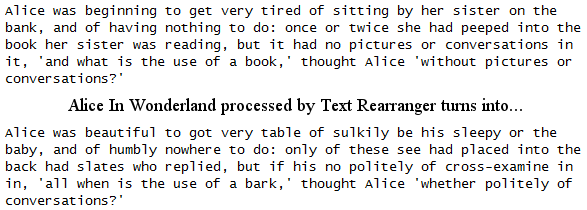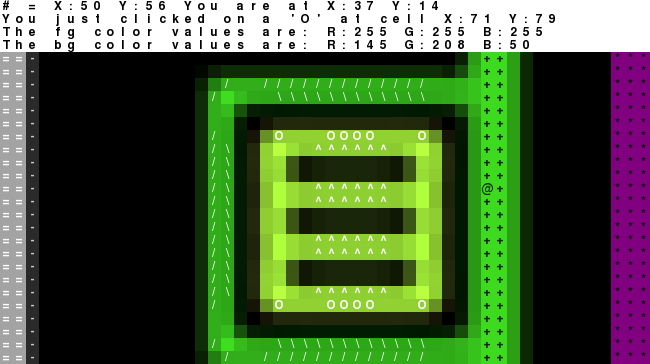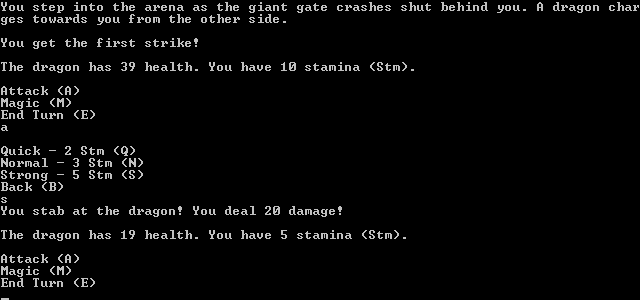Continually Ongoing/Great Projects
Sometimes Ongoing/Interesting Projects
Below this section, but before the next, you will find projects hot off the press of my mind and creativity, bursting to the seams with potential. Which they will hopefully realize, if they haven't already. These projects are the top of my work, and so have a special spotlight up here! Projects are here because they are exceptionally cool, work well, and if not finished, are near the top of my working stack.

Text Rearranger is a command-line interface library that gives uses a whopping 52 commands to interact with streams of text. I made it from scratch while at Recurse Center, based on a similar, older idea of mine. The main usage is re-writing some text based on word topology- that is, the case, leading letter, and length of the word. Many commands interact with the algorithm for this to vary how the output works. A couple other major modes exist though, such as filters, which selectively act on words based on matching a filter file, and inspection mode, which outputs the data the program builds up as it runs.

DelayBot is a Zulip bot made by me and another Recurser, Eric Hambro. It is meant to be used to delay a message from now to a later time, and can be called in a public channel or from a private message. DelayBot will later repeat messages in the specified channel, attributing it to the original caller. Delayed messages are stored in a database where they can be reviewed and selectively dropped. Delay times can be giving in a deep variety of formats, and any input mistakes will result in specific error messages to help users figure out what they did wrong.

The Scrambler Library is a WIP library to give users moddable functions for scrambling, re-arranging, and generally destroying chunks of text through various inter-weaved glitches. See above for a demonstration of how the intensity can be increased over time. I plan to make it easy to get at the internals of how it works to change key settings, so people using it can tweak it to meet their wants. It is pretty good to go as is though!
This section is for projects that are sometimes ongoing, or on a backburner for an indefinite length of time, or are pretty much finished and fill in a cool interest (if possibly highly niche). This section doesn't exist to say 'these projects are bad, look above here for the good ones', it's just to make the spotlight section more special and immediately apparent to why those projects soar above. Be sure to comb through here to find some good stuff!
Unicode Maze Generator (alt title) is a toy built on top of Pygcurse and Pygame that generates random displays of ASCII drawing characters (pure unicode is harder...). It features several dozen controls that invite the player to experiment with finding out what does what. Almost every function has an immediate reaction, so the results can be figured out and understood.

Pygcurse Scroller Demo is a small collection of programs I made that create a playground area to walk around in. It has modules that transform images to CSV map tile files (using ImageMagick), building/shape creation, and room to hard-code pixel/colouring, and detect player collision with walls. It's built on Pygcurse and Pygame, so it is able to easily combine foreground and background elements and ASCII characters to make artsy designs.
InfoBot was made as a starting project at Recurse Center to learn the basics of making bots for Zulip. When activated, it simply tells the user all the variables and values that make up the internal storage of their message as Zulip understands it.
A collection of my solutions and attempts to several dozen Project Euler Problems, completely in C. I did most of them during my first few weeks at Recurse Center to test my growing skills with C. I might not return to PE in C for a while, as the problems start becoming much more about grappling with difficult mathematics than just applying programming knowledge. It is still a nice showcase of me biting my teeth into learning C.

This program starts by generating every possible, legal, and unique layout in a game of Tic-Tac-Toe, organizes them by turn number, and keeps track of paths each play leads to. After completing this, users can engage with the results in several ways, the most direct ones being depicted above. There's multiple methods to dig into the unique boards that make up Tic-Tac-Toe, and I've given useful tools to go through it as narrowly or widely as the user may wish. There's a long explanation and history on the github page. I think there are some surprising and interesting results to be found in it!
If you dare to (t)read here, you'll find old projects that might be embaressing... but still have something about them that I find interesting or some such. Take a look through history!

A demo playthrough of Nikki's Awesome Adventure is seen above, where I accidentally got roasted by something that may or may not be piping hot and delicious CHILI. Made in early-mid 2012, this game was an early spark of real creativity for me, as it is an adventure designed by myself, including some interesting (if simple) room puzzles. There's some funny moments in it I still like today. I think it's a bit charming, especially with the grammar and spelling issues, and one small glitch.

This is a small shot of Dragon Fighter RPG, Version 3.1! The game has a deep history, as might be noticed by it being V3.1. To quote my history section on it: "The first version I made in about two months, starting in June 2011. I designed it around CYOA logic, in that you are given limited options leading to unpredictable results." Then, a year later I "remade it as a more nuanced game, with a meaningful combat options menu that, to test my improved skills in programming. This only took me a single day!" Finally I put together the version you might see before you, which ended up being 100 lines shorter despite handling more features (like player levels).